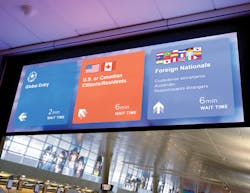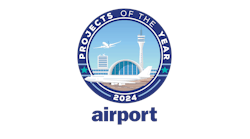Multilingual wayfinding at Dallas Fort Worth International Airport (DFW) helps passengers with little or no English proficiency navigate the airport process. Synect and the DFW customer experience team collaborated to deliver smart, translated content at key decision points along the DFW passenger journey.
Through improved wayfinding and messaging, DFW wanted to make the airport more accessible and friendlier. As the passenger experience is enhanced, airport operations are enhanced through increased throughput, enhanced flow and the ability to help international travelers find their way to and through Customs and Border Protection (CBP), and to their gate or the airport terminal exit.
“The multilingual project implemented is only one part of our digital transformation that we have been and will continue to implement in the coming years,” said Ken Buchanan, DFW Executive Vice President – Revenue Management and Customer Experience.
Synect’s Passenger360 digital signage platform went live in 2021 as part of DFW’s Terminal D extension.
“It was initially deployed at DFW’s Terminal D South to create a lounge-like atmosphere and help passengers relax at the boarding area while easily seeing gate status from anywhere within the space,” said Yahav Ran, Synect CEO.
The system grew to support the multilingual wayfinding initiative, which went live months later in September 2021.
Valuing customer feedback, DFW conducted an English proficiency study with passengers as international flights arrived at the airport. “We combined this study with a complete signage review of our international connecting journey and identified several areas of opportunity to enhance our international customers’ experience,” Buchanan said.
Passengers see multilingual messages as they head to CBP, leave CBP and head to connecting flights or the airport terminal exit, choose security checkpoints and look for their gates.
DFW displays English and up to three other languages at one time. Passenger360 supports Arabic, Dutch, Chinese Simplified, French, German, Italian, Japanese, Korean, Portuguese and Spanish and others as needed.
If flights were coming in to DFW from New York, Brazil, France and Germany, the CMS would display English, Portuguese, French and German. The language displayed is automated by the smart system.
“It is reactive to true airport activity. Because the solution is integrated with the AODB (airport operations database) and receives the flight schedule and the flight country of origin, it is showing translations based on the languages most likely to be needed at any given time,” Ran said.
In other words, no one needs to schedule the content to play in English and German at 10 a.m.
“Passenger360 automatically reads the flight schedule and cross-references that with the incoming flights’ country of origin and ‘knows’ when it needs to show content in German,” Ran said. “If a flight from Germany gets delayed, the system will automatically adjust to the new arrival time, again without any manual intervention from airport operators.”
If a flight is coming in from New York, and no other flights take a higher priority for language, the system would display English and Spanish. There is always a second language, ran said, adding it's often Spanish, and there would be times when a third language is not shown.
The content management system maps flight data against custom business rules that indicate what languages should be played. An additional layer of intelligence makes decisions on the priority of the languages to be shown at a given time. For example, passengers from Colombia may be less proficient in English than travelers from Germany. Therefore, the Spanish language has a higher priority than German. The language priority is configurable based on the origin of the flight.
In addition to appearing in multiple languages, the messages are animated. For example, a car indicates the way toward the exit while an airplane shows the way to connecting flights and gates.
“This helps with comprehension and allows passengers to ‘glance and go,’” Ran said.
On the backend, deployment, configuration and customization are Synect’s responsibilities and coordinated with airport IT.
“The airport ensures we meet all of their benchmarks around important items like security, user acceptance testing, and more,” he said.
Ran describes the CMS interface as airport centric, designed specifically for airport operations to run the system. “The airport has complete operational control of the CMS via the Passenger360 user interface that is customized to and optimized for airport operations, as opposed to a non-aviation-focused CMS,” he said.
DFW defines and oversees the message. “Content adheres to DFW’s brand guidelines, including taxonomy and iconography,” he continued. “It is all part of a cohesive, consistent content library that started at the Terminal D Extension and expanded to other displays at DFW. All backgrounds are custom-created for and approved by DFW, and they are used across all the Passenger360-driven screens at the airport to provide a cohesive environment.”
In total DFW has approximately 1,300 to 1,500 screens. The Passenger360 system at DFW drives 37 LG screens.
They are located in Gates of the Future in Terminal D and include four LCD screens, six LED screens and 16 OLED screens. Multilingual digital signage includes two LCD screens and four LED screens.
In addition to the Terminal D extension and multilingual wayfinding, the CMS is used to drive a concessions LED video wall in Terminal D and displays in the “High C” gates (C35 and C37). In Terminal C, DFW wayfinding digital signage includes four LED screens (two double-sided displays).
With the successful completion of the now award-winning project, Buchanan said, “Multilingual signage has been expanded to other areas like our new Terminal C renovation project for our high-numbered gates and is currently being included in our designs for future projects as well.”
“The solution goes far beyond legacy digital signage solutions and can be easily updated to adapt to changing scenarios and needs at the airport,” Ran added.
For its technical achievement and visualization of dynamic, integrated data, the multilingual wayfinding project received two 2023 Digital Signage awards. The global Digital Signage Awards are an annual international search for outstanding campaigns, creative executions and technical innovations, and remarkable media or placement solutions in the fields of digital signage, digital out-of-home advertising and digital visual experiences.
DFW was also selected for the 2022 Airport Service Quality (ASQ) award for Best Airport that serves over 40 million passengers in North America by the Airports Council International (ACI). The ACI ASQ award is reflective of DFW’s commitment to providing a memorable and unique customer experience to all who fly through DFW.
Before the platform was put in place, static, legacy digital signage was used in the baggage recheck/customs and for airside wayfinding.






